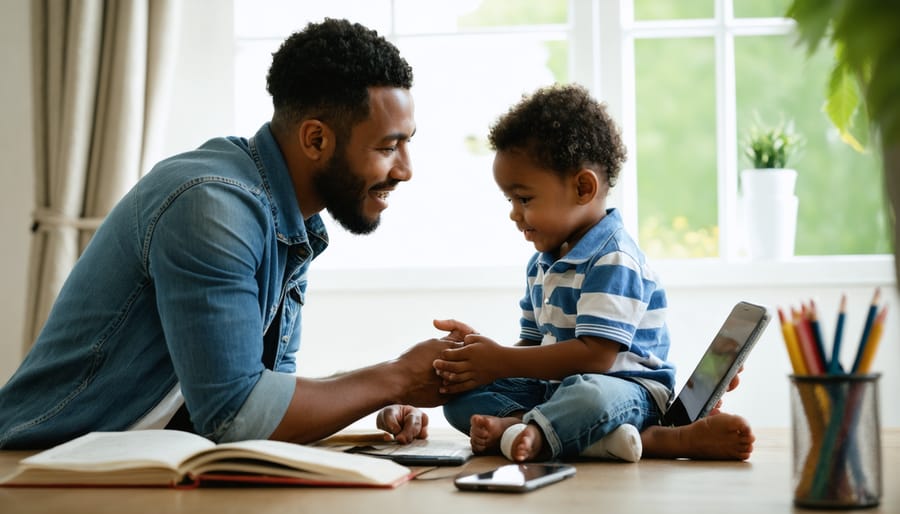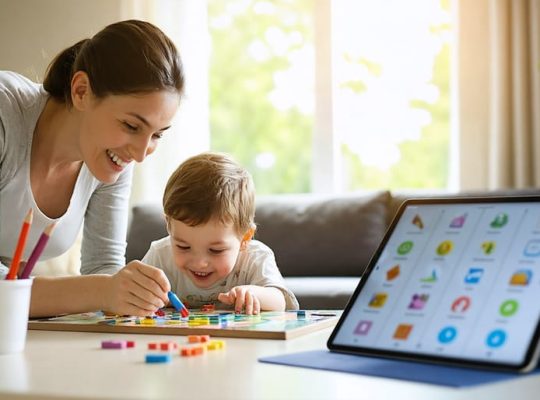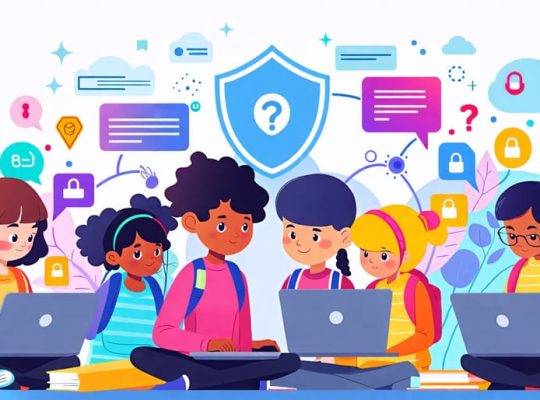As parents, we’re witnessing an unprecedented surge in digital anxiety among our children. The constant connectivity, social media pressures, and endless notifications are creating a new kind of stress that’s fundamentally different from what previous generations experienced. Recent studies show that the screen time impact on mental health can be significant, particularly during crucial developmental years.
Yet this isn’t just about limiting device use or enforcing strict digital boundaries. Digital anxiety represents a complex interplay between technology, social development, and emotional well-being. Our children are growing up in a world where their online and offline lives are increasingly intertwined, making it essential for us to understand and address their digital-related stress with empathy and practical solutions.
As both a parent and mental health advocate, I’ve seen firsthand how digital anxiety can manifest in subtle ways: a teenager’s persistent fear of missing out, a young child’s emotional outbursts when disconnected from devices, or a tween’s overwhelming pressure to maintain a perfect online presence. These challenges require a nuanced approach that balances digital literacy with emotional support.
In this article, we’ll explore practical strategies to help your child navigate the digital landscape while maintaining their mental well-being. Whether you’re dealing with a tech-savvy teenager or a young child just beginning their digital journey, you’ll find actionable steps to foster a healthier relationship with technology.

Signs Your Child Is Experiencing Digital Anxiety
Physical Symptoms
Digital anxiety can manifest in various physical symptoms that parents and caregivers should watch for in their children. Many young people experience headaches and eye strain from prolonged screen time, often accompanied by neck and shoulder tension. These symptoms typically worsen after extended periods of social media use or online gaming.
Sleep disturbances are another common physical indication, with children having trouble falling asleep or experiencing restless nights, especially after using devices before bedtime. Some youth report stomach aches or nausea when faced with overwhelming digital situations, such as numerous unread messages or pending social media notifications.
Other physical signs include:
– Shallow breathing or rapid heartbeat when receiving notifications
– Sweaty palms while checking social media
– Muscle tension, particularly in the jaw and shoulders
– Fatigue despite minimal physical activity
– Changes in appetite or eating patterns
Dr. Sarah Chen, a pediatric psychologist, notes: “These physical symptoms often mirror those of traditional anxiety, but they’re specifically triggered by digital interactions. Parents should pay attention to when these symptoms occur and what digital activities precede them.”
Emotional and Behavioral Changes
Digital anxiety often manifests through noticeable changes in a person’s emotional state and daily behaviors. Children and teens might become increasingly irritable or show sudden mood swings, especially when disconnected from their devices. Parents often notice their children withdrawing from face-to-face social interactions, preferring online communication over real-world connections.
Common behavioral changes include checking devices compulsively, showing signs of restlessness when unable to access technology, and experiencing difficulty focusing on non-digital activities. Many young people report feeling overwhelmed by the constant stream of notifications and social media updates, leading to decreased sleep quality and changes in eating patterns.
Dr. Sarah Chen, a child psychologist, notes: “I’ve observed children becoming increasingly anxious about missing out on online interactions. This can lead to physical symptoms like headaches and stomach aches, particularly before school or social events where device use isn’t permitted.”
Watch for signs like decreased interest in previously enjoyed activities, sudden academic performance changes, or expressing feelings of loneliness despite constant online connectivity. These changes often signal that digital anxiety is affecting your child’s well-being.
Creating a Healthy Digital Environment
Setting Boundaries
Establishing clear boundaries around technology use is crucial for managing digital anxiety in children. Start by creating a family media plan that includes specific screen-time limits and designated tech-free zones in your home. Many families find success with digital detox strategies that begin with small, manageable steps.
Consider implementing these practical boundaries:
– Set device-free mealtimes to encourage family connection
– Create a “parking station” for devices outside bedrooms at night
– Establish screen-free periods during homework time
– Designate specific areas in the home as tech-free zones
Dr. Sarah Thompson, a child psychologist, shares: “When families establish consistent boundaries around technology use, children often experience reduced anxiety and improved sleep patterns. The key is to implement these rules with compassion and clear communication.”
Remember to lead by example. Children are more likely to respect digital boundaries when they see parents following the same rules. Start conversations about why these boundaries matter, focusing on the positive impacts like better sleep, more time for creative play, and stronger family relationships.
Be flexible and adjust boundaries as needed, but maintain consistency with core rules. Celebrate small wins when your child successfully follows these guidelines, and offer gentle reminders when boundaries need reinforcing.

Building Digital Resilience
Building digital resilience in children starts with teaching them how to navigate online spaces confidently while maintaining their emotional well-being. Just as we help children overcome anxiety in the physical world, we can empower them to handle digital challenges with grace and confidence.
Start by establishing open conversations about online experiences, creating a safe space where children feel comfortable sharing their concerns. Teach them the cyber safety essentials while emphasizing that it’s normal to feel overwhelmed sometimes.
Help your child develop healthy coping strategies, such as:
– Taking regular breaks from screens
– Practicing mindful technology use
– Setting boundaries with social media
– Distinguishing between helpful and harmful online content
– Building real-world connections alongside digital ones
Encourage them to trust their instincts about uncomfortable online situations and remind them that it’s okay to disconnect when feeling overwhelmed. Create technology-free zones and times at home, making space for face-to-face interactions and offline activities.
Remember that digital resilience isn’t about avoiding technology altogether but learning to use it in a way that supports mental well-being. Celebrate their successes in navigating digital challenges and be patient as they develop these essential life skills.
Communication Strategies

Opening the Conversation
Starting a conversation about digital anxiety with your child can feel daunting, but approaching the topic with empathy and curiosity makes a significant difference. Rather than beginning with concerns or criticism, try opening with genuine interest in their digital experiences.
Consider starting with simple observations: “I notice you seem a bit stressed after being online. Would you like to talk about it?” This approach shows you’re paying attention without being judgmental. Share your own experiences too – perhaps a time when social media made you feel overwhelmed or when you needed a digital break.
Choose the right moment for these discussions. After dinner, during car rides, or while taking a walk together often provide natural opportunities for meaningful conversations. Avoid bringing up the topic when your child is already feeling anxious or defensive about their technology use.
Remember to listen more than you speak. Ask open-ended questions like “What’s your favorite part about being online?” or “How do you feel after spending time on social media?” These questions encourage reflection and help your child feel heard and understood.
If your child seems reluctant to open up, be patient. Sometimes it takes multiple gentle attempts before they’re ready to share their digital experiences and concerns.
Active Listening Techniques
When children express concerns about their digital experiences, practicing active listening becomes crucial for understanding and addressing their anxieties. Start by creating a judgment-free zone where your child feels safe sharing their thoughts and feelings about online interactions.
Give your full attention during these conversations by putting away your own devices and maintaining eye contact. Use encouraging phrases like “Tell me more about that” or “That sounds challenging” to show you’re engaged and interested in their perspective.
Validate their emotions by acknowledging that their feelings are real and important. For instance, if your child feels overwhelmed by social media comparisons, respond with “I understand why that would feel stressful” rather than dismissing their concerns with “It’s just social media.”
Practice reflective listening by paraphrasing what they’ve shared: “So you’re feeling anxious when you see your friends posting about events you weren’t invited to?” This helps ensure you’ve understood correctly and shows your child you’re truly listening.
Remember to ask open-ended questions about their digital experiences, allowing them to guide the conversation. This approach helps you better understand their specific challenges while strengthening your parent-child bond through meaningful communication.
When to Seek Professional Help
While digital anxiety is common, certain signs indicate a need for professional support. If your child’s anxiety about technology begins to significantly impact their daily life, relationships, or academic performance, it’s time to consult a mental health professional.
Watch for these key indicators:
– Persistent physical symptoms like headaches, stomach aches, or sleep problems related to technology use
– Extreme emotional reactions when devices are unavailable or during screen time limits
– Social withdrawal or refusing to participate in non-digital activities
– Declining grades or difficulty concentrating at school
– Panic attacks or severe anxiety when separated from devices
– Expression of hopelessness or worthlessness related to social media
– Obsessive checking of devices or social media accounts
Dr. Sarah Chen, a child psychologist, shares: “When digital anxiety starts interfering with a child’s ability to function normally in daily activities, that’s a clear sign professional help is needed. Early intervention can prevent the development of more serious mental health issues.”
Consider seeking professional help if:
– Your child’s anxiety persists despite implementing recommended coping strategies
– Home-based interventions aren’t showing improvement after several weeks
– Your child expresses thoughts of self-harm or severe depression
– Family conflicts about technology use become unmanageable
– Your child shows signs of technology addiction
Remember, seeking professional help isn’t a sign of failure – it’s a proactive step toward supporting your child’s mental health. Mental health professionals can provide specialized strategies, family therapy, and additional resources tailored to your child’s specific needs.
Many schools now have counselors trained in digital wellness who can serve as a first point of contact. Additionally, pediatricians can recommend qualified mental health professionals who specialize in children’s digital anxiety and technology-related stress.
As we navigate the digital age together, remember that experiencing anxiety about technology use is a common challenge for both parents and children. The key is finding balance and maintaining open communication with your children about their digital experiences. By recognizing the signs of digital anxiety early, implementing healthy boundaries, and creating tech-free zones and times, you can help your child develop a healthier relationship with technology.
Remember that every child is different, and what works for one family may not work for another. Trust your parental instincts while remaining flexible and adaptable in your approach. Focus on progress rather than perfection, and celebrate small victories as your family works together to manage digital anxiety.
If you notice that your child’s digital anxiety is significantly impacting their daily life, don’t hesitate to seek professional help. Mental health professionals can provide valuable guidance and support tailored to your child’s specific needs.
Most importantly, you’re not alone in this journey. Many parents are facing similar challenges, and resources are available to help. By staying informed, maintaining compassionate communication, and implementing consistent strategies, you can help your child thrive in our increasingly digital world while protecting their mental well-being.
Keep the conversation going, stay patient, and remember that building healthy digital habits is a gradual process that will benefit your child’s long-term emotional health.







